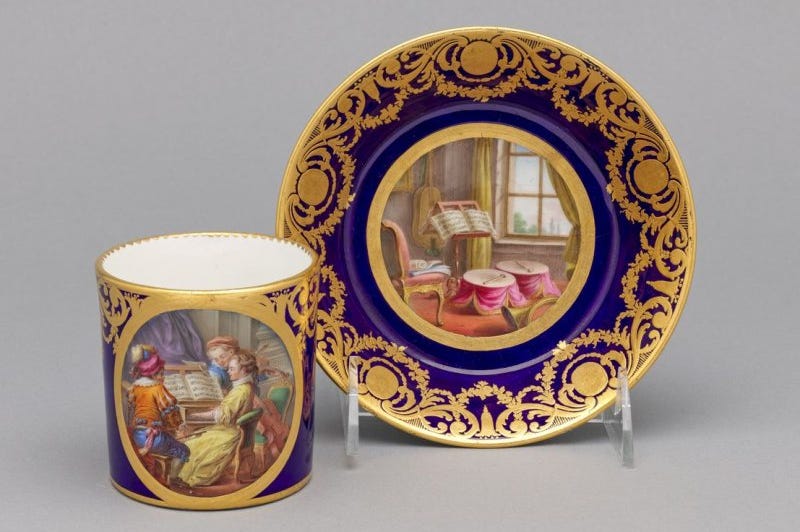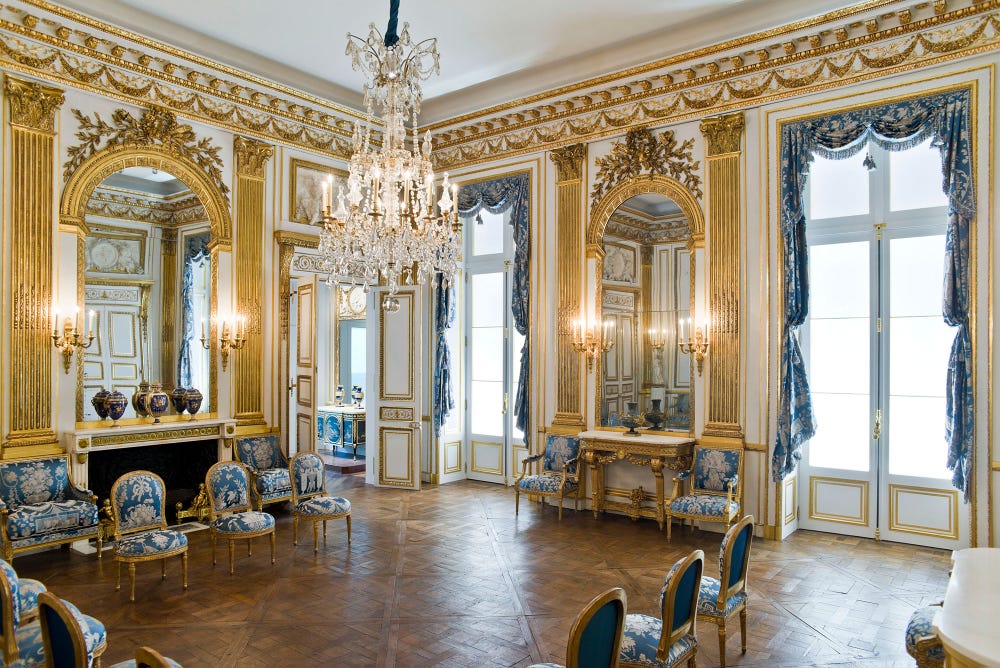Panel with a Vase of Flowers (detail), 1600–1650, Florence, Italy, attributed to Matteo Nigetti, Opificio della Pietre Dure (Granducal Hardstone Workshops). Hardstones (lapis lazuli, amethyst, Sicilian jasper, Sienese agate, chalcedony, and carnelian), marbles (verde antico, rosso antico, bianco e nero), and alabaster, set into black Belgian marble, 52 3/4 x 27 5/8 in. Fine Arts Museums of San Francisco, Museum purchase, gift of Diane B. Wilsey, Roscoe and Margaret Oakes Income Fund, Raymond L. Parker Bequest Fund, Dorothy Spreckels Munn Bequest Fund, Ruth L. & Alfred B. Koch Trust; Genevieve Knowles Woods Bequest Fund; Fine Arts Museums Foundation Auction Proceeds; and the Michael Taylor Fund, 2005.93
About European decorative arts
European Decorative Arts have been an essential part of the Legion of Honor since its founding. In addition to her own collections, the Legion’s founder, Alma de Bretteville Spreckels, secured donations of French 18th-century furniture, decorative arts, and mounted porcelain from the Collis P. Huntington Collection and Mildred Anna Williams. Mrs. Spreckels also received gifts of contemporary Sèvres porcelain from the French government that reinforced the collection’s focus on the artistic culture of France.
Ranging in scope from late medieval to modern times, the collection has expanded in recent years to cover many other regions of Europe, with highlights such as a Spanish ceiling dating from about 1500, a hard-stone panel from the grand-ducal workshops of Florence of 1600 – 1650, and a Nymphenburg crucifixion group modeled by Franz Anton Bustelli contained in a house altar from Munich, ca. 1760. Notable French decorative arts include Pierre Gole’s spectacular ebony cabinet from ca. 1650, a settee made for Queen Marie-Antoinette, the Coventry secrétaire of 1763 made by B.V.R.B., and three period rooms, including the recently renovated Salon Doré from the Hôtel de La Trémoille, Paris. Highlights of British decorative arts include Horace Walpole’s commode of 1763 from Strawberry Hill, west of London, furniture from St. Giles House, Dorset, and grand silver by Paul Storr. Among the collection’s porcelain masterworks are a magnificent Meissen vase representing early production from the factory of Augustus the Strong, a set of vases from Sèvres of 1768, and the extensive Bowles collection, showcasing the history of English porcelain in the 18th century. Twentieth-century standouts are a Fabergé tea table and silver tea service given by a member of the former Russian imperial family that is one of the Legion’s earliest acquisitions.
-
The Bowles Porcelain Gallery
The Porcelain Gallery is a much-loved component of the Legion of Honor. A project initiated by the museum's founder, Alma de Bretteville Spreckels, it shows an array of porcelain and pottery from England and continental Europe, with a strong emphasis on the 18th century. The front section of the gallery is devoted exclusively to the story of English porcelain, from the early days of the Chelsea factory to the widespread production of Worcester. The back section tells the story of Continental porcelain and pottery. Highlights include the Bowles collection of Chantilly, as well as Meissen, Sèvres, Gutter, Schwartz, Margaretten, and maiolica made in Renaissance Italy. The pieces in the front of the gallery constitute the extensive collection of English porcelain gifted by Constance and Henry Bowles to the museum in 1991, and those of George McNear Bowles. The gallery also features contemporary porcelain works. Adjacent to the gallery is the Ceramic Study Center, which provides additional resources and research materials.
Charles-Nicolas Dodin, 1778. Soft-paste Porcelain, 7.3 x 9.8 x 7.3 cm (2 7/8 x 3 7/8 x 2 7/8 in.) cup; 3.2 x 14.6 x 14.6 cm (1 1/4 x 5 3/4 x 5 3/4 in.) saucer. Fine Arts Museums of San Francisco, Bequest of the J. Lowell Groves 1984 Living Trust and European Art Trust Fund, 2009.28a-b
-
The Salon Doré at the Legion of Honor
This magnificent salon is one of the finest examples of French neoclassical interior architecture in a museum and the only complete example of a pre-Revolutionary Parisian salon on display anywhere. Designed during the reign of Louis XVI, it was originally installed in the Hôtel de la Trémoille on Paris's Rue Saint-Dominique as the salon de compagnie (the principal reception room) of this aristocratic mansion. The architecture of the Salon Doré — with its giant gilded Corinthian pilasters framing four arched mirrors crowned with trophies of Love and War — was intended to invoke the grandeur of ancient Rome. Such a stately classical impression conveyed the knowledge and the social status of the owners, the ducs de la Trémoille — a French aristocratic family of ancient lineage — who placed this formal entertaining salon quite literally in the heart of their house. Learn more.


